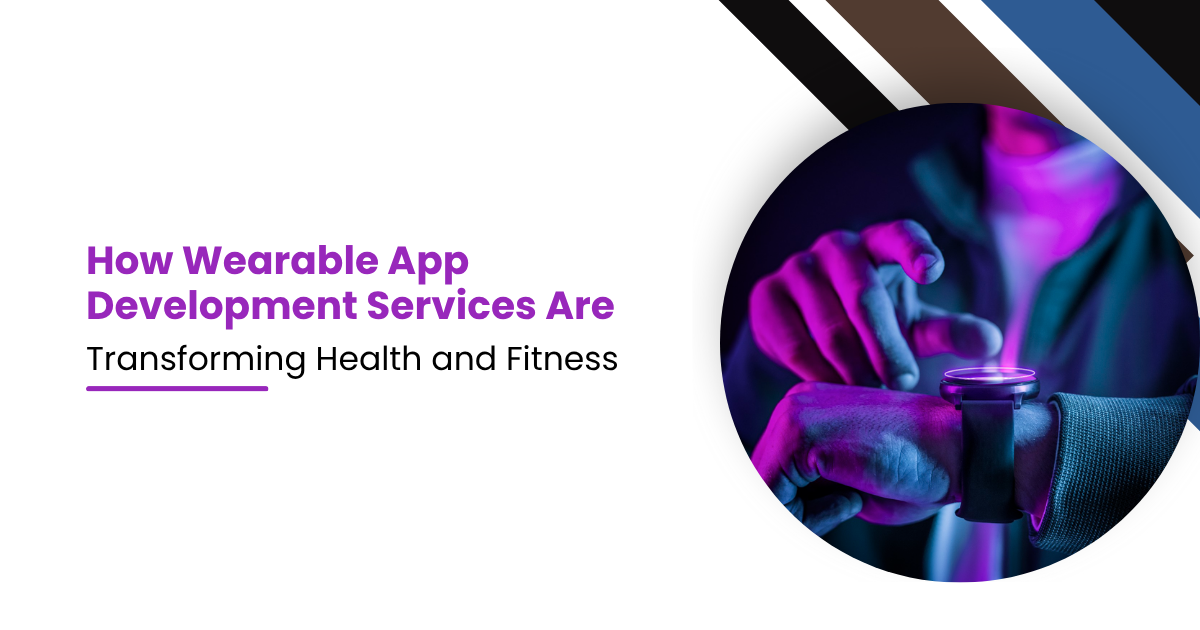How Wearable App Development Services Are Transforming Health and Fitness

The health and fitness industry is experiencing a revolution, largely driven by technology. According to Grand View Research, the global wearable technology market was valued at $61.30 billion in 2020 and is projected to expand at a compound annual growth rate (CAGR) of 16.9% from 2021 to 2028. This boom can be attributed to advancements in wearable app development services that are helping users track their fitness goals and live healthier lives.
Wearable devices like fitness trackers, smartwatches, and health-monitoring gadgets are providing real-time insights into individuals' health metrics, from heart rate to sleep patterns. The impact of wearable app development companies is profound, as these businesses help bring these innovative devices to life, creating apps that offer customized fitness experiences, data analytics, and real-time health information.
What Are Wearable App Development Services?
Wearable app development services refer to the process of creating mobile applications designed to sync with wearable devices such as smartwatches, fitness bands, and health monitors. These apps collect data from the wearable devices and offer functionalities like tracking physical activity, sleep patterns, heart rate, and other fitness metrics. Additionally, they provide real-time feedback, personalized recommendations, and health reports to the user.
A wearable app development company is responsible for developing these apps, ensuring they are user-friendly, secure, and compatible with various wearable devices. These services include app design, development, and ongoing support to ensure seamless integration with the wearables' hardware.
Key Benefits of Wearable App Development Services in Health and Fitness
The rise of wearable app development services has brought significant benefits to the health and fitness sector. These apps are not just about tracking data; they offer comprehensive insights that improve users’ health outcomes.
Here are some of the key benefits:
-
Personalized fitness plans: Wearable apps can track progress and suggest customized fitness routines based on real-time data.
-
Data-driven insights: Users can track health metrics over time, allowing them to adjust their lifestyle for better health.
-
Motivation: By providing progress reports and achievements, wearable apps encourage users to maintain a consistent fitness routine.
-
Real-time health monitoring: Wearables can monitor key health parameters such as heart rate, oxygen levels, and calories burned during physical activity.
For example, a fitness tracker app can offer daily activity goals based on the user’s health data and send reminders to stay active, ensuring better adherence to fitness plans.
Also Read: Wearable Device Apps: Changing Everyday Life with Smart Technology
How Wearable Apps Enhance User Experience
The key to successful wearable technology lies in providing an exceptional user experience. Wearable app development companies focus on designing intuitive, easy-to-use interfaces that integrate seamlessly with wearable devices. The combination of hardware and software allows users to get the most from their devices.
Here’s how wearable apps improve user experience:
-
Real-time feedback: Instantaneous feedback helps users monitor their progress and make adjustments quickly. For instance, a runner can receive real-time updates on pace, distance, and calories burned during their workout.
-
Integration with other health apps: Many wearable apps integrate with other health and fitness platforms, like Apple Health and Google Fit, allowing users to consolidate their health data in one place.
-
Engaging and motivating features: Gamification and social sharing features encourage users to meet their fitness goals by earning rewards, sharing progress with friends, and competing in challenges.
The Role of Data in Wearable Health Apps
Data is the backbone of wearable app development services. With wearable devices continuously collecting health metrics such as steps taken, calories burned, heart rate, and sleep quality, this data can be analyzed to provide actionable insights for improving health.
Some key types of data collected by wearable apps include:
-
Activity tracking: Wearables track physical activity such as steps, cycling, and running, providing metrics on duration, intensity, and frequency.
-
Heart rate monitoring: Wearables monitor heart rate throughout the day, helping users optimize workouts and maintain healthy heart rhythms.
-
Sleep tracking: Many wearable devices offer sleep analysis, measuring factors like duration, quality, and sleep cycles.
-
Stress levels: Some wearables measure stress through heart rate variability and provide recommendations for managing stress.
By processing this data, wearable app development companies create apps that offer health recommendations, personalized workouts, and diet plans based on the user’s unique data.
Real-Time Health Monitoring and Alerts
Wearable app development services have made it possible to offer continuous, real-time health monitoring. Whether it's tracking heart rate during exercise or monitoring oxygen levels, wearable apps provide users with a detailed picture of their health throughout the day.
Real-time health data is crucial in emergency situations. For instance, if a user’s heart rate goes beyond a safe threshold, the app can alert the user to take immediate action or seek medical help. This feature can be life-saving for individuals with chronic conditions like cardiovascular disease or diabetes.
For businesses, this opens new opportunities in the healthcare sector by offering services that can aid in preventive care, reducing hospital visits and enhancing patients' quality of life.
How Wearable App Development Services Drive Business Growth
The surge in wearable technology has provided businesses with significant opportunities to reach customers in new and innovative ways. Here’s how wearable app development companies are driving growth in the health and fitness industry:
-
New revenue streams: By offering subscription-based services, app-based challenges, or in-app purchases, companies can generate recurring revenue from users.
-
Customer engagement: Wearable apps increase engagement by offering users personalized experiences, health tips, and progress updates.
-
Brand loyalty: Wearables and their apps can enhance customer loyalty by encouraging users to continue using a brand’s products and services.
-
Business insights: Companies can gather valuable insights into customer behavior, preferences, and health trends by analyzing data from wearable apps.
For example, a fitness company could offer a premium subscription for personalized workout plans, coaching, and nutrition advice, increasing both customer retention and revenue.
Wearable Apps for Fitness Professionals
Fitness professionals are also benefiting from wearable app development services. Personal trainers and wellness coaches can use these apps to track their clients' progress, monitor their health metrics, and provide more effective guidance. Many trainers now use wearable apps to:
-
Track their clients’ activity levels and adjust workout plans accordingly.
-
Provide real-time feedback during sessions.
-
Offer remote coaching through apps that integrate wearable data.
This shift is transforming the fitness industry, allowing coaches to deliver more data-driven, personalized training programs for their clients.
The Role of AI in Wearable Fitness Apps
Artificial Intelligence (AI) is playing a crucial role in enhancing the functionality of wearable apps. AI algorithms can analyze the vast amounts of data collected by wearable devices and provide predictive insights. For instance, AI can analyze a user’s workout data and recommend future routines or predict potential health issues based on trends in their data.
Additionally, AI can optimize app performance by personalizing recommendations based on users’ behavior. For example, if an AI-powered app notices that a user is consistently not reaching their fitness goals, it might adjust the intensity or frequency of their workout recommendations.
The Future of Wearable App Development
The future of wearable app development services is full of exciting possibilities. As technology continues to evolve, wearables will become even more sophisticated and capable of tracking a wider range of health metrics.
Key trends to look out for include:
-
Integration with healthcare providers: Wearable apps may become a primary tool for doctors to monitor patients' health remotely and offer telemedicine services.
-
Biometric sensors: Advanced sensors that measure vital signs like blood pressure and glucose levels will likely be integrated into future wearables, providing a more comprehensive health monitoring experience.
-
Augmented reality (AR) integration: AR could provide real-time visual feedback during workouts, helping users perform exercises with better form and technique.
These innovations will continue to shape the future of health and fitness, providing users with more advanced tools for maintaining optimal health.
Conclusion
Wearable app development services have significantly impacted the health and fitness industry by providing users with valuable tools to track, monitor, and improve their health. From real-time feedback to personalized fitness plans and AI-powered recommendations, these apps have transformed the way people approach wellness.
As technology continues to advance, the future of wearable apps will likely see even more sophisticated features, integrating deeper data analytics, real-time monitoring, and AI-driven insights. For businesses in the health and fitness sector, wearable app development companies offer a unique opportunity to connect with consumers, drive engagement, and innovate within an increasingly tech-driven market.
By leveraging wearable technology, businesses can offer tailored solutions that empower users to take control of their health and fitness journey. The opportunities for growth, engagement, and customer satisfaction are immense, making wearable app development services a critical part of the modern fitness landscape.
- Art
- Causes
- Crafts
- Dance
- Drinks
- Film
- Fitness
- Food
- Games
- Gardening
- Health
- Home
- Literature
- Music
- Networking
- Other
- Party
- Religion
- Shopping
- Sports
- Theater
- Wellness
- IT, Cloud, Software and Technology


